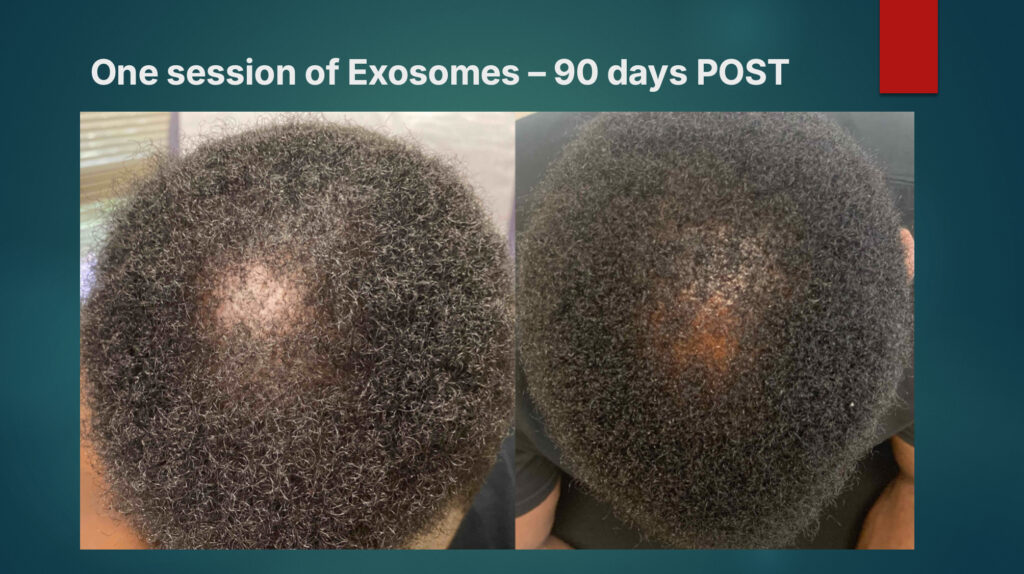 One session of exosomes – 90 days POST
One session of exosomes – 90 days POST
When I was kindly asked to speak to my colleagues at the 20th World Congress for the Academy of Aesthetic Medicine in Orlando, Florida, I selected the topic of exosomes and how they are becoming the new standard of regenerative medicine for many treatment pathways in the cosmetic medicine. I was preceded by Marcelo Suarez, MD and proceeded by Nadia Schiavo, MD, PhD. All of these exosome presentations expounded on the expansion of this ever-growing field of knowledge.
Exosomes were first discovered by Porter and Roth in 1964, but their research was expounded by Nieuwland from the Netherlands in 1996 and later Lotvall in Sweden in 2007. I first became aware of exosomes at a meeting of the American Academy of Anti-Aging Medicine, of which I am a fellow, in the year 2019. My interest in exosomes was to use them as an alternative for platelet-rich plasma.
Platelet-rich plasma had been used in the United States with variable success in Europe and Asia for over 20 years for androgenetic alopecia or male and female pattern baldness when I first began using it in 2016 at my Dallas and Irving, Texas locations. I was the first dermatologist in Dallas-Fort Worth area to use it for that purpose as it was not FDA approved, and is still not to this day.
Dr. Jeffrey Rappaport wrote a paper which was the first in the U.S. to clearly explain why our colleagues across the Atlantic and Pacific had found clear success in the use of PRP, while American physicians had inconsistent results. He instructed the proper use of platelet-rich plasma required a series of at least four injections spaced one month apart, followed by every six month repeat injections for maintenance, after a complete lab work up to rule out any other type of underlying systemic issues. In this way, the follicular bulb and bulge would be able to once again communicate on a cellular level, allowing the hair in the follicle to regrow and prevent miniaturization in the case of androgenetic alopecia.
Unfortunately, search engines such as Google and inappropriate use of PRP by various providers across the nation invalidated PRP to the consumer by creating confusion in the general market place. If a provider were to use terms such as PRP on their website, they would actually be downgraded due to algorithms put in place by some of the widely used search engines.
In addition, by using PRP on a frequent basis, I saw inconsistencies myself from patient to patient. Fluid intake, hormone levels, medications, vitamins and mineral supplementation and proper nutrition all had effects on the harvest of the plasma, and therefore consistency on the outcome of the PRP injections.
Enter exosomes. Exosomes are subcellular particles ranging in size from 30-150 nanometers. They carry biomarkers from their donor cells, and contain mRNA, growth factors, angiopoietin (which stimulate blood vessels), and cytokines (which increase growth and maturation of stem cells).
Exosomes are not FDA approved, but can be harvested from various types of tissue such as bone marrow, fat, umbilical cord tissue or blood. The lab from which a clinician receives exosomes should be FDA approved, and the exosomes should be tested and also third-party tested as well based on section 361. The lab from which I source my exosomes, for example, is Thomas Labs, and they are derived from umbilical cord tissue.
As always, patients should sign an informed consent stating this information prior to undergoing a procedure, just as they sign an informed consent before any and all procedures in a physician’s office.
Exosomes are safe, effective and will grow hair but with less injections (typically only 1-2) per year. There is no harvest required from the patient, which is quite appealing. Results are consistent because the source is consistent, tested and then re-tested by a third party.
Additional uses of exosomes besides regrowth of hair in the aesthetic arena, include faster and better outcomes post-laser and energy-based devices, specifically if the skin is ablated or partially ablated such as in the case of microneedling, radiofrequency microneedling, or non-ablative resurfacing lasers. Exosomes can be injected intra-dermally in a microdroplet technique using a needle or a cannula in patients who prefer to avoid neuromodulators or traditional fillers.
As we continue to learn more about these subcellular particles called exosomes and all they can offer us in advancing aesthetics, the sky appears to be the limit. Schedule your cosmetic consultation now at the Dermatology Office by calling (214)373-7546 and learn how to harness the power of exosomes. www.dermofficedallas.com


Written by Dallas Dermatologist, Ellen Turner, M.D.

